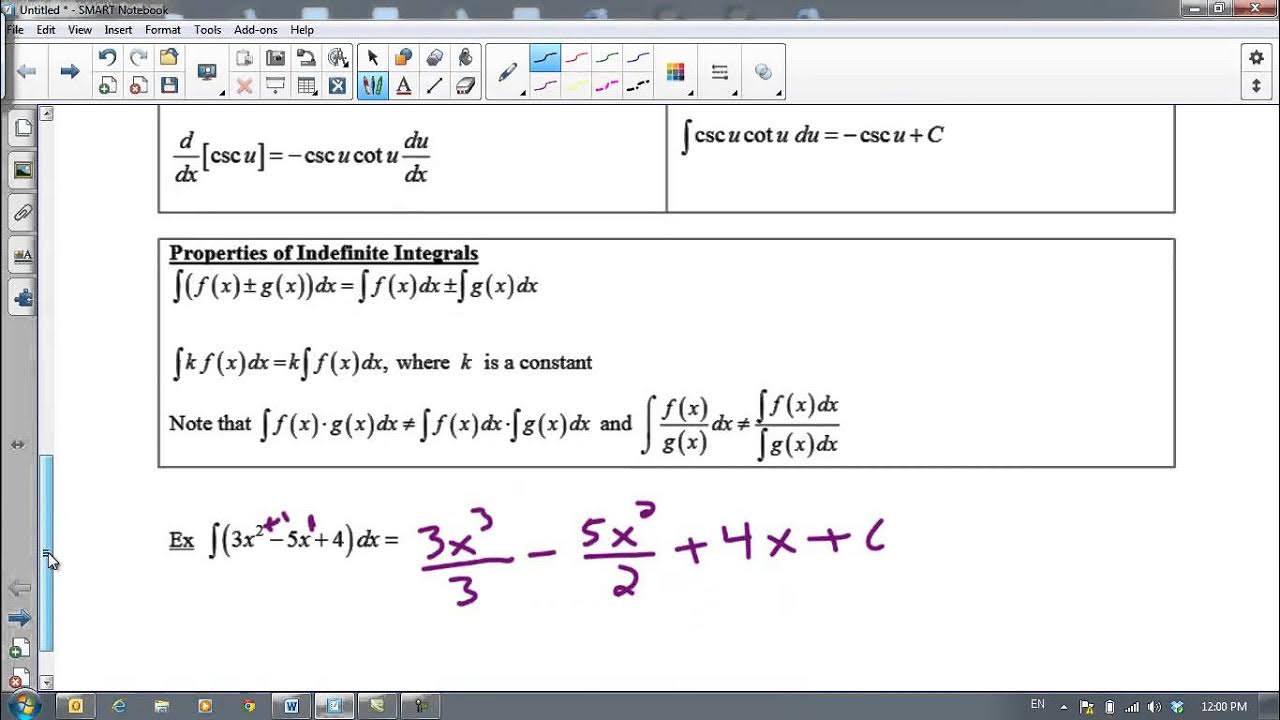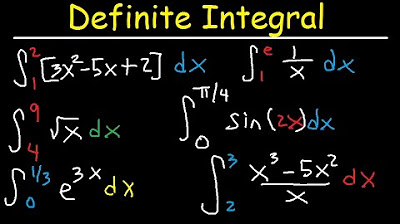Calculus AB Homework 6.1 Antiderivatives
TLDRThis video tutorial guides viewers through solving 14 calculus homework problems, focusing on finding antiderivatives of various functions. It covers the reverse power rule, integration of polynomials, and special cases like square roots and logarithmic functions. The instructor emphasizes the importance of simplifying expressions before integration and provides strategies for memorizing derivative rules to ease the process. The video concludes with solving for a function given its second derivative, showcasing the application of integration in reverse.
Takeaways
- 📚 The video is a tutorial on solving calculus homework problems, specifically antiderivatives of various functions.
- 🔍 The first problem involves finding the antiderivative of the sum of the cube root of x and x, using the reverse power rule to integrate.
- 📈 For the second problem, the antiderivative of 2x is found by increasing the exponent and simplifying the result.
- 📉 Problem three requires simplifying the expression before integrating, resulting in an antiderivative involving x to the power of 5/5, 3x to the power of 4/4, and a constant.
- 🎯 In problem four, the power rule is applied directly to integrate functions without simplification, leading to an antiderivative with terms involving x to the power of 5/2 and x squared.
- 🛑 The fifth problem emphasizes the memorization of derivative rules, particularly for square roots, to quickly find antiderivatives.
- 📝 Problem six involves simplifying the expression before integrating, using the power rule for negative exponents and recognizing the antiderivative of 1/x as ln|x|.
- 🔢 In problem seven, the power rule is used to integrate a function with the same base by adding exponents, resulting in y to the power of 9/2.
- 📘 Problem eight simplifies the expression to use the power rule for integration, finding the antiderivative of 1/w^(3/2) as -2/w^(1/2).
- 🔄 Problem nine involves simplifying and then integrating, using the power rule and memorized derivatives for square roots and their inverses.
- 📌 Problem ten requires simplifying the polynomial expression before applying the power rule to find the antiderivative, resulting in terms of x to various powers.
- 🌐 Problem eleven treats theta as a variable and uses the power rule to integrate, including the antiderivative of cosine as sine plus a constant.
- 📐 Problem twelve uses the power rule to integrate the square root of x, and the antiderivative of negative sine x as cosine plus a constant.
- 🔑 In problem thirteen, the antiderivative of a given function is found by integrating its derivative, and a constant is determined using a given condition.
- 🔄 Problem fourteen involves integrating a given second derivative to find the original function, including solving for a constant using a given condition.
Q & A
What is the antiderivative of the cube root of x plus x?
-The antiderivative of the cube root of x plus x is \( \frac{3}{4}x^{\frac{4}{3}} + \frac{x^2}{2} + C \), where C is the constant of integration.
How do you find the antiderivative of 2x?
-The antiderivative of 2x is \( x^2 + C \), found by increasing the exponent by 1 and dividing by the new exponent.
What is the antiderivative of x squared times 2 plus 3x?
-The antiderivative is \( \frac{2x^5}{5} + \frac{3x^4}{4} + C \), which simplifies to \( \frac{2}{5}x^5 + \frac{3}{4}x^4 + C \).
How do you integrate x squared over x cubed?
-The integral of x squared over x cubed is \( \frac{3}{x} + \frac{1}{x^2} + \frac{3}{x^3} \), which can be rewritten as \( 3x^{-1} + x^{-2} + 3x^{-3} \).
What is the antiderivative of the square root of x?
-The antiderivative of the square root of x is \( 2\sqrt{x} + C \), using the power rule by adding 1 to the exponent and dividing by the new exponent.
How do you integrate 1 over 2 root x?
-The antiderivative of 1 over 2 root x is \( \sqrt{x} + C \), as the derivative of \( \sqrt{x} \) is \( \frac{1}{2\sqrt{x}} \).
What is the antiderivative of 3x squared divided by x cubed?
-The antiderivative is \( 3\ln|x| + \frac{1}{x} - \frac{3}{2x^2} + C \), using the natural logarithm for the first term and the power rule for the others.
How do you find the antiderivative of y cubed times y to the 1/2?
-The antiderivative is \( \frac{2}{9}y^{\frac{7}{2}} + C \), by adding the exponents and applying the power rule.
What is the antiderivative of 1 over w to the 3/2?
-The antiderivative is \( -\frac{2}{\sqrt{w}} + C \), using the power rule and rewriting the expression with a negative exponent.
How do you integrate x to the power 3 over x to the power 1/2 plus 3 over the square root of x?
-The integral is \( \frac{5}{2}x^{\frac{5}{2}} + 6\sqrt{x} + C \), by simplifying the expression and applying the power rule to each term.
What is the antiderivative of x plus 3 times x squared minus 6x plus 9?
-The antiderivative is \( \frac{x^4}{4} - \frac{3x^3}{3} - \frac{9x^2}{2} + 27x + C \), which simplifies to \( \frac{x^4}{4} - 3x^3 - \frac{9x^2}{2} + 27x + C \).
How do you find the antiderivative of x squared plus cosine x?
-The antiderivative is \( \frac{x^3}{3} + \sin(x) + C \), using the power rule for the polynomial term and the fact that the derivative of sine is cosine.
What is the antiderivative of the square root of x with the derivative of cosine x?
-The antiderivative is \( x^{\frac{3}{2}} - \sin(x) + C \), applying the power rule to the square root term and recognizing the antiderivative of cosine as sine.
How do you find the function f(x) given its derivative f'(x) = 2x - sin(x)?
-The function f(x) is \( x^2 + \cos(x) + 3 \), integrating the given derivative and solving for the constant C using the initial condition f(0) = 4.
What is the function f(x) if f''(x) = x squared?
-The function f(x) is \( \frac{x^4}{12} + 6x + 3 \), integrating twice and solving for the constants using the initial conditions f'(0) = 6 and f(0) = 3.
Outlines
📚 Antiderivative Calculations for Homework Problems
This paragraph introduces the video's focus on solving antiderivative problems from unit six, specifically problems one through fourteen. The speaker begins by rewriting the first problem's expression and applying the reverse power rule to find the antiderivative of cube root of x plus x. The process involves adjusting exponents and simplifying the expression to arrive at the final antiderivative, which includes a constant of integration. The explanation continues with problem two, where the antiderivative of 2x is found by adjusting the exponent and simplifying, leading to the result of x squared minus x cubed plus a constant. The speaker also suggests checking answers by differentiating the antiderivative to see if it matches the original function.
🔍 Simplification and Integration Techniques
The second paragraph delves into the process of simplifying expressions before integrating, as demonstrated with problem three. The speaker distributes x squared and multiplies it by constants, resulting in an expression ready for integration. The power rule is applied to find the antiderivative of each term, leading to the final expression involving x to the power of various fractions plus a constant. The paragraph also discusses the importance of considering domain restrictions, especially when dealing with logarithmic functions, and the correct application of the power rule for integration.
📘 Advanced Integration Strategies and Problem Solving
In the third paragraph, the speaker addresses more complex integration problems, including the use of power rule variations and memorized derivative rules. The paragraph covers the integration of expressions involving square roots and rational functions, emphasizing the need to simplify before integrating where possible. The speaker also discusses the integration of trigonometric functions and the use of substitution to simplify the process. Each integration step is carefully explained, leading to the final expressions for the antiderivative of given functions.
📝 Constructing Functions from Derivatives and Solving for Constants
The final paragraph focuses on constructing original functions from their derivatives and solving for constants within the context of integration problems. The speaker demonstrates how to integrate a given function to find the original function and then uses given values to solve for the constant of integration. The process involves understanding the relationship between derivatives and antiderivatives, applying the power rule, and using memorized derivatives of common functions. The paragraph concludes with the determination of the original function for a given second derivative, showcasing the application of integration in function reconstruction.
Mindmap
Keywords
💡Antiderivative
💡Reverse Power Rule
💡Integration
💡Simplification
💡Power Rule
💡Derivative
💡Constant of Integration
💡Square Root
💡Natural Logarithm
💡Sine and Cosine Functions
Highlights
Introduction to solving unit six homework problems one through fourteen.
Finding the antiderivative of cube root of x plus x using reverse power rule.
Simplifying the expression for antiderivative calculation of 2x and x squared.
Using the power rule for integration and checking answers by differentiation.
Simplifying the expression before integrating x squared times 2 and x squared times 3.
Integrating 2x to the fourth power over 5 and 3x to the fourth power over 4.
Applying the power rule for integration without simplification.
Rewriting the square root of x as x to the power 1/2 for easier integration.
Integrating 1 over 2 root X using memorized derivative rules.
Simplifying the expression 3x squared over x cubed before integration.
Integrating terms with negative exponents and using the natural logarithm function.
Rewriting y cubed times y to the 1/2 and applying the power rule.
Simplifying 1 over w to the 1 times w to the one-half and using the power rule.
Simplifying x to the power 3 over x to the power 1/2 plus terms before integration.
Integrating x plus 3 times x squared minus 6x plus 9 with power rule.
Treating theta as a variable and integrating theta squared plus cosine theta.
Integrating square root of x as x to the power 3/2 and negative sine x.
Solving for f(x) by integrating 2x minus sine x and finding the constant C.
Finding f(x) by integrating f double-prime of x and solving for the constant C.
Transcripts
5.0 / 5 (0 votes)
Thanks for rating:





